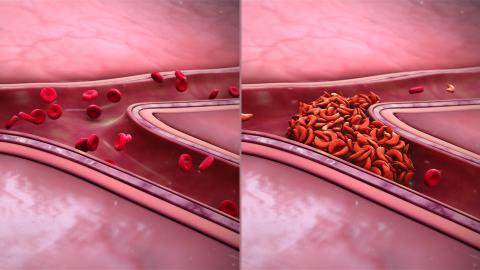Cycles of sickles

Redoxoma Highlights by Danilo Grünig Humberto da Silva, from Department of Biology, UNESP/IBILCE, São José do Rio Preto
Sickle cell anemia is a prevalent form of anemia caused by mutation of one aminoacid in the hemoglobin chain. This induces red blood cells (RBCs) to undergo cycles of contraction, especially under hypoxia, assuming a sickle shape, leading to impaired oxygen transport, hemolysis, vascular occlusion, profound anemia and several other clinical consequences. Redox processes have been thought to contribute to the sickling processes and their implications, but the overall pitcture remains obscure. Recent work from CEPID-Redoxoma helped unravel some of these aspects. This study investigated addressed how RBCs from patients with sickle cell anemia deal with redox metabolism disruption. It investigated the generation of specific oxidative lesions, and the levels of an unexplored antioxidant that could act as a candidate biomarker for oxidative status in sickle cell anemia. Rigorous exclusion criteria were used to obtain the studied groups, which were composed of 10 subjects without hereditary anemias and 10 sickle cell anemia patients. The results indicated that the patient´s RBCs overwhelm the antioxidant defense system, leading to an impaired antioxidant capacity that significantly contributed to the increase in lesion markers and hemolysis. Moreover, there were alterations on markers of all biochemical pathways evaluated in the patient´s RBCs. In particular, the levels of an amino acid with antioxidant properties, named ergothionein, were decreased by two-fold in patient´s RBCs. Importantly, there were strong associations of ergothioneine levels with other RBC metabolism markers, suggesting that its supplementation could be proposed as possible therapeutic alternative for sickle cell anemia treatment. Therefore, impaired antioxidant capacity results in a loss of cellular metabolism control, contributing to a decreased lifespan of the patient´s RBCs.
Article:
- N. A. Chaves, T. G. P. Alegria, L. S. Dantas, L. E. S. Netto, S. Miyamoto, C. R. Bonini Domingos, D. G. H. da Silva. Impaired antioxidant capacity causes a disruption of metabolic homeostasis in sickle erythrocytes Free Radical Biology and Medicine, 141: 34–46, 2019. | doi: 10.1016/j.freeradbiomed.2019.05.034
Add new comment